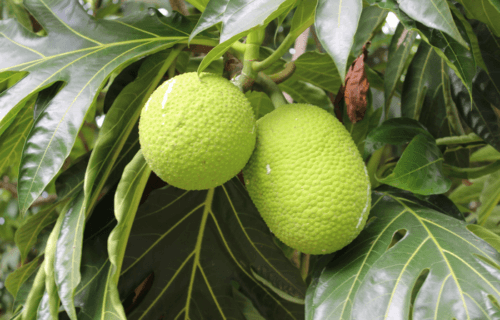EVANSTON, Ill. — The answer to beating climate change may be to plant more breadfruit trees, a new study contends.
While studies predict that climate change will have an adverse effect on many crops worldwide, researchers from Northwestern University say global warming trends will have little effect on breadfruit production. Breadfruit is a starchy tree fruit native to the Pacific islands. Although it’s a fruit, people often use breadfruit as a substitute for potatoes because it’s so starchy and seedless.
Previous studies have even celebrated the fruit as a “superfood,” due to how rich in nutrients it is — containing high levels of fiber, vitamins, and minerals. In the tropics, people have been eating breadfruit for thousands of years in a variety of different ways. These include steaming, roasting, frying, or fermenting the common crop. You can also turn breadfruit into flour to lengthen its shelf life and export it.
Unlike rice, corn, and soybeans, the new study finds breadfruit is resilient enough to withstand extreme changes to the environment. Moreover, they found new regions that can grow breadfruit which face high levels of food insecurity and are vulnerable to the worsening global hunger crisis.
“Breadfruit is a neglected and underutilized species that happens to be relatively resilient in our climate change projections,” says Northwestern’s Daniel Horton in a university release. “This is good news because several other staples that we rely on are not so resilient. In really hot conditions, some of those staple crops struggle and yields decrease. As we implement strategies to adapt to climate change, breadfruit should be considered in food security adaptation strategies.”
Climate change will have little to no impact on breadfruit
Since global warming is making tropical regions both warmer and wetter, study authors wanted to see if this would impact breadfruit’s ability to grow in its native climate. They first mapped out what climate conditions these trees need in order to properly grow breadfruit. The team then looked at climate change models, predicting what the weather will look like in these areas in 2060 and 2080.
Specifically, the projections looked at two scenarios: one where rising greenhouse gas emissions continue to plague the world and one where emissions stabilize in the future. In both scenarios, regions that are suitable for growing breadfruit trees remained relatively unchanged. In the tropics and subtropics, the amount of suitable land for growing breadfruit only decreased by 4.4. to 4.5 percent.
Researchers also found that there is suitable land for growing this crop in other regions, including sub-Saharan Africa, where people don’t usually plant these trees.
“Despite the fact that climate will drastically change in the tropics, climate is not projected to move outside the window where breadfruit is comfortable,” says study first author Lucy Yang. “From a climate perspective, we can already grow breadfruit in sub-Saharan Africa. There is a huge swath of Africa, where breadfruit can grow to various degrees. It just has not been broadly introduced there yet. And, luckily enough, most varieties of breadfruit are seedless and have little-to-no likelihood of becoming invasive.”
“Breadfruit trees can live for decades and provide a large amount of fruits each year,” adds Nyree Zerega, director of the Program in Plant Biology and Conservation. “In some cultures, there is a tradition to plant a breadfruit tree when a child is born to ensure the child will have food for the rest of their life.”
Breadfruit could put an end to world hunger
Zerega says that once people establish a breadfruit tree, they are capable of withstanding heat and drought much longer than most other crops. They’re also a perennial crop, meaning they require less energy and effort in comparison to crops that farmers need to replant every year. Breadfruit tress also sequester carbon dioxide from the atmosphere, making them extremely important for the environment.
“A lot of places where breadfruit can grow have high levels of food insecurity,” Yang says. “Oftentimes, they combat food insecurity by importing staple crops like wheat or rice, and that comes with a high environmental cost and carbon footprint. With breadfruit, however, these communities can produce food more locally.”
Researchers say that, due to the ongoing war in Ukraine, the coronavirus pandemic, and climate change, global food insecurity is becoming a greater problem every day. They believe that planting more breadfruit trees can create more resilience in the global food system.
“Climate change further emphasizes the need to diversify agriculture, so the world doesn’t rely on a small number of crop species to feed a large number of people,” Zerega concludes. “Humans rely heavily on a handful of crops to provide most of our food, but there are thousands of potential food crops among the approximately 400,000 described plant species. This points to the need to diversify agriculture and crops globally.”
The findings appear in the journal PLOS Climate.

